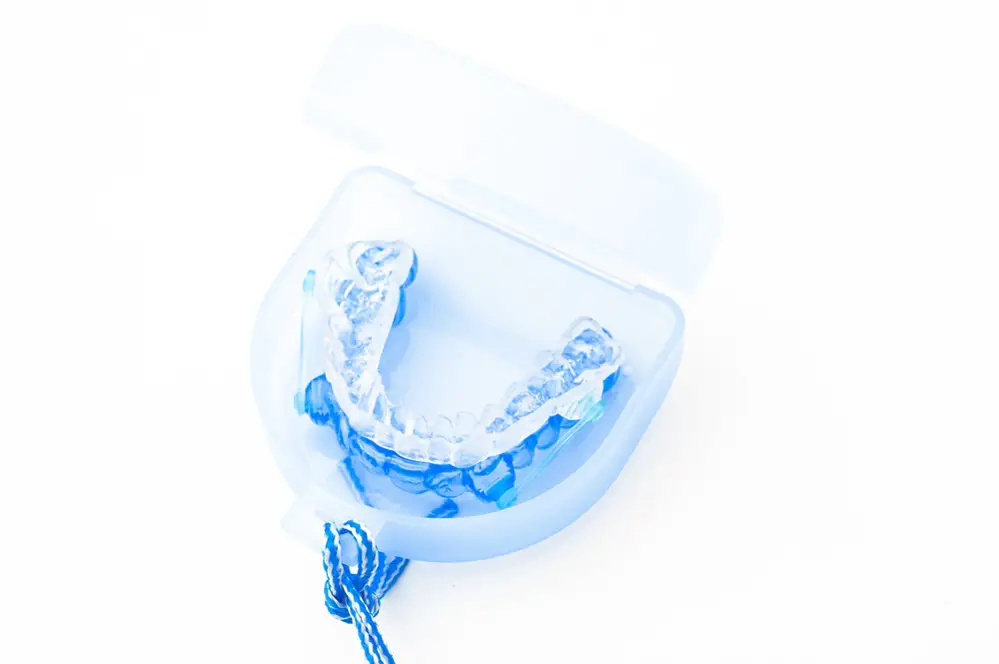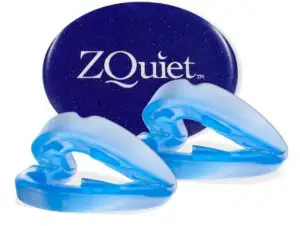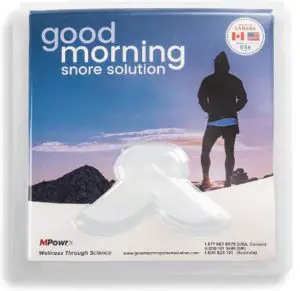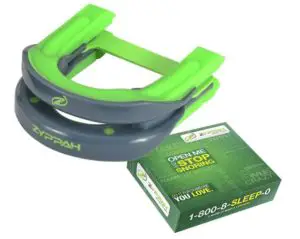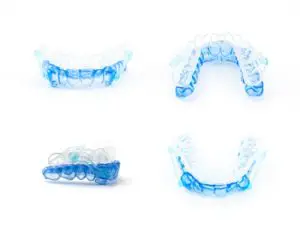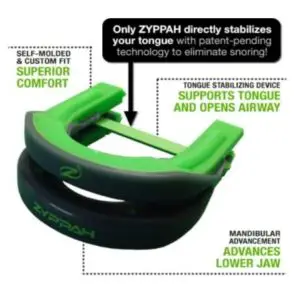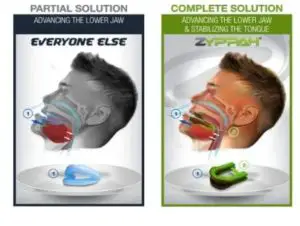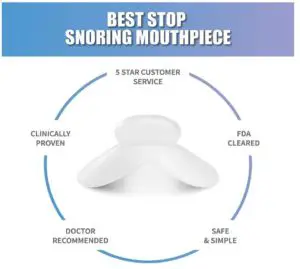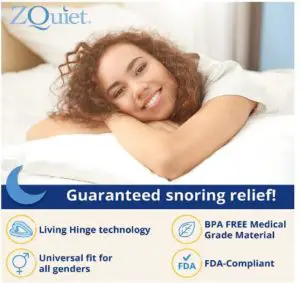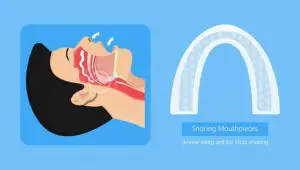Shopping for an Anti-Snoring Mouthpiece?Let us help you pick out the right one!
Snoring is a problem that affects almost half of the total American population. There are numerous reasons why one might be experiencing it. For instance, it can happen because of airway obstruction, or it can be a sign of an underlying sleep disorder.
Regardless of its exact cause, some approaches can definitely help you reduce the severity of your snoring, if not entirely eliminate it. And one of the best ways is to use anti-snoring mouthpieces and mouthguards.
So, if you’re fed up with the weird, eccentric home remedies and ineffective, expensive machines, consider investing in the best anti-snoring mouthpiece.
What’s in this Buying Guide
Snoring is a nuisance that disturbs both your and your partner’s beauty sleep.
Whether it's you or your partner who snores, this guide will help you find the perfect anti-snoring mouthpiece to help solve the dilemma.
In this guide, we review the best mouth guards for snoring and mention their pros and cons.
We also discuss all its different types and point out the features to look out for when buying one.
Finally, we discuss the care and maintenance of snoring mouthpieces and answer some FAQs so that you can easily pick the best mouthpiece for snoring.
Best Anti-Snoring Mouthpieces
- Best Mandibular Alignment Device: ZQuiet Anti-Snoring Mouthpiece
- Best Tongue Retention Device: Good Morning Snore Solution Mouthpiece
- Best Hybrid Anti-Snoring Mouthpiece: ZYPPAH Anti Snoring Hybrid Oral Appliance
Disclaimer: All links below go to Amazon.com
| Product | Award | Size Options | Customizable | Adjustable | Material | Sleep Trial |
|---|---|---|---|---|---|---|
ZQuiet Anti-Snoring Mouthpiece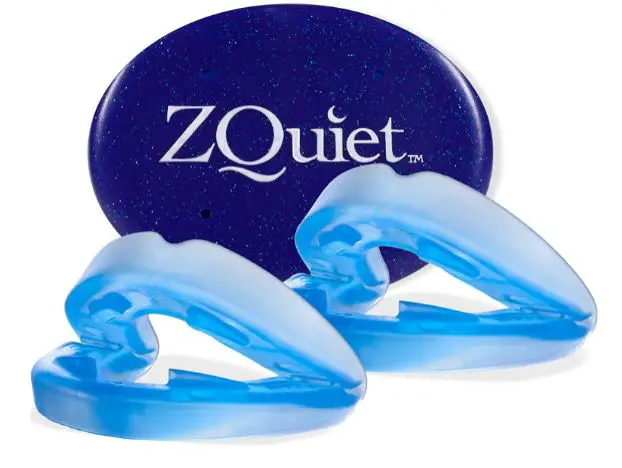 | Best Mandibular Alignment Device | 2 | No | Yes | BPA free Medical Grade thermoplastic elastomer | 30 days |
Good Morning Snore Solution Mouthpiece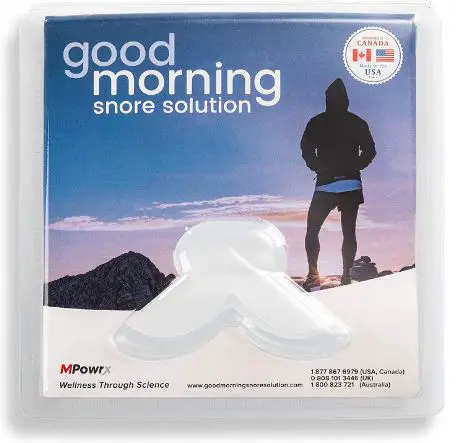 | Best Tongue Retention Device | 3 | No | No | Clinically safe plastic resin | 30 days |
best snoring mouthpiece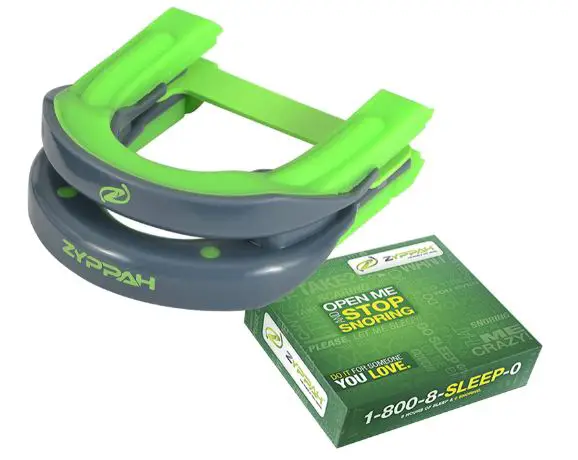 | Best Hybrid Anti-Snoring Mouthpiece | Universal | Yes | No | FDA approved thermoplastic | 90 days |
1. Best Mandibular Alignment Device: ZQuiet Anti-Snoring Mouthpiece
ZQuiet is a simple anti-snore mouthpiece. This MAD does not require any customization.
ZQuiet comes as a pack of 2 differently sized mouthguards, with one slightly smaller than the other. You can try them both to find your perfect fit.
With ZQuiet, there is no need for the time-consuming boil-and-bite process. Plus, it comes with a 30-day sleep trial and a 60-day money-back guarantee.
Pros
- Hinged design for better comfort
- Made with FDA-approved thermoplastic elastomer
- Ready to use straight out of the box
- Includes two mouthpieces with different degrees of jaw advancement
- Simple to clean and maintain
Cons
- Small airway opening
- Not for people with full dentures or weak teeth
Our Review
The greatest selling point of ZQuiet is that it comes as a set of 2 differently sized mouthpieces. It is designed as a starter kit to help snorers.
One of the mouthpieces advances the lower jaw 2 millimeters forward while the other advances the jaw 6 millimeters forward.
ZQuiet recommends that you start with the 2-millimeter size and advance to the 6-millimeter size if you continue to snore.
Both the mouthpieces are made of high-quality, medical-grade thermoplastic elastomers and automatically adjust to the dimensions of your mouth and jaw without any mold or customizations.
There is also no need to prepare them beforehand with the boil-and-bite method. They are ready to use straight out of the box.
The ZQuiet mouthpiece is pretty easy to clean and comes with its own storage box. The hinged design makes it more comfortable to use. Plus, it comes with small slits for breathing through the mouth.
2. Best Tongue Retention Device: Good Morning Snore Solution Mouthpiece
If you snore because your tongue falls back into the throat, the Good Morning Snore Solution Mouthpiece is the perfect solution.
It is a TRD that effectively restrains your tongue from relaxing backward towards your throat. With its soft plastic resin construction, the Good Morning snore stop mouthpiece creates a gentle suction to hold your tongue forward.
There are no size issues or customization required with this device. And, it comes with a 30-day money-back guarantee too, talk about a win-win situation.
Pros
- Simple and very easy to use
- Lightweight and compact
- Doesn’t need any adjustment or customization
- Gentle on your teeth and jaw
- Works with dentures, implants, bridges, and crowns
Cons
- Can cause tongue soreness
- Does nothing against nasal congestion
Our Review
Good Morning Snore Solution is easily one of the best anti-snoring mouthpieces. It features a flexible plastic resin construction that makes it pretty easy to use.
Although it is not drastically different from other TRDs available in the market and is both ISO certified and FDA approved proving to be both safe and effective.
Good Morning Snore Solution controls snoring by stretching the front of the tongue forward for better stability. This “stabilizing” effect ensures that a normal airflow is maintained during sleep.
Unlike MADs, you don’t need to customize or adjust this device – it is ready to use out of the box.
And the best part is that it is safe to use with dentures, implants, bridges, and crowns.
3. Best Hybrid Anti-Snoring Mouthpiece: ZYPPAH Anti Snoring Hybrid Oral Appliance
Not sure of the reason behind your snoring? The Zyppah Anti Snoring Hybrid Oral Appliance can help you out.
This hybrid device combines the functions of both MADs and TRDs.
It is a MAD-style mouthpiece that also incorporates a tongue strap to hold your tongue away from the throat.
You can customize it according to mouth anatomy with the boil-and-bite method. And, it comes with a 90-night sleep trial, so you can easily figure out whether it is right for you or not.
Pros
- Hybrid design addresses snoring in a better way
- Customizable according to your fit
- Made with FDA-approved materials
- Use and cleaning are easy
- Universal size fits most mouths
Cons
- Non-adjustable
- No openings for breathing via the mouth
Our Review
Celebrities have endorsed the Zyppah anti-snoring mouthpiece, and it has also been discussed on numerous TV shows.
The patented design has dual functionality and is very effective against snoring. Zyppah Anti-Snoring Mouthpiece combines the working principles of both MADs and TRDs.
First, the mouthpiece realigns your lower jaw to move forward. Next, the tongue strap pulls and holds your tongue in a stable position.
The device is not very adjustable, and you first have to prepare it with the boil-and-bite method.
The material of both the upper and lower trays of the Zyppah anti-snore device is thermoplastic and is designed to help you easily create your unique dental impression.
Once you get the impression, all you have to do is place the device inside your mouth every night before sleeping.
Buying Guide: Anti-Snoring Mouthpieces
What is an Anti-Snoring Mouthpiece – and How Does it Work?
Snoring happens when your airway is narrowed or obstructed. A device that goes into your mouth to help keep the airway open is termed an anti-snoring mouthpiece.
Despite its significant effectiveness, it is a fairly simple device with a few individual parts.
The way it works actually depends upon the type of anti-snoring mouthpiece you have.
Some anti-snoring devices advance your jaw by at least 1mm when you place them in your mouth. Others restrain your tongue and prevent it from falling back into your throat and constricting your airways.
Types of Anti-Snoring Mouthpieces
Anti-snoring mouthpieces are of 2 types – Mandibular Alignment Devices (MADs) and Tongue Restraining Devices (TRDs).
MADs
The medical term for your lower jaw is the mandible. Sometimes as you sleep, your mouth relaxes to slide back toward the back of the throat. This position constricts your airways, making you snore.
A Mandibular Alignment Device or MAD is a type of anti-snoring mouthpiece that keeps your lower jaw in a forward position.
You hold a MAD in your mouth by biting on it, so it is also helpful for people who have a habit of grinding teeth as they sleep.
MADs usually have thermoplastic material in the upper and lower trays where your teeth are intended to fit. You can customize a MAD according to your dental structure by using the boil-and-bite method.
A MAD is most effective when you wear it with your mouth closed. This way, more breathing takes place through the nose, which reduces the chances of snoring.
However, some MADs still sport small holes that allow air to flow in and out the mouth.
TRDs
Snoring also happens when your tongue falls back into the throat, obstructing the airway to make you snore.
A Tongue Retention Device or TRD holds and stabilizes your tongue in place so it does not fall into this snore-inducing position. It pulls the tongue forward to create a wide gap between the tongue and the back of the throat to reduce snoring.
While it may sound like a medieval torture device, it really is not that painful.
Of course, you should expect some discomfort, but you get used to it after some nights.
The device achieves its purpose through a gentle suction, which acts as the restraining tool to keep the tongue away from the throat.
You hold a TRD in your mouth by keeping it close, so it also promotes nasal breathing.
However, if you have nasal congestion, a TRD may not be a good option unless it has holes for oral breathing.
Why Buy an Anti-Snoring Mouthpiece Over Other Anti-Snoring Remedies?
Obstructed airways are not the only reason for snoring. Your lifestyle and genes also play a role.
The anatomy of your mouth and sinuses, alcohol consumption, allergies, a common cold, and your weight can all bring on a case of sawing logs.
While anti-snoring mouthpieces are certainly a common pick, they are not the only way to silent your sawing logs.
There are numerous other anti-snoring remedies currently available in the market.
Here’s how they compare to anti-snoring mouthpieces.
Anti-Snoring Mouthpieces vs. Anti-Snoring Chin Straps
The effectiveness of anti-snoring mouthpieces and chin straps has been a hot debate amongst snorers.
While a mouthpiece goes inside your mouth to keep the airways open, a chin strap is elastic and holds your mouth closed, and in place, so it does not relax into a snore-inducing position.
Although both are quite effective at reducing snoring, mouthpieces take the front stage because they address the root cause of the problem.
The different MADs and TRDs alone are enough to handle the snore-causing muscles. Some combination devices can also retain your tongue and realign the mandible to stop snoring from its root.
Chin straps may stop the mouth from obstructing your airway, but they do little to retain your tongue, which can cause you to continue snoring.
Anti-Snoring Mouthpieces Vs. Anti-Snoring Nasal Dilator
Nasal dilators are also known as nasal cones, vents, or clips. These nasal appliances hold your nostrils open to maximize breathing for better sleeping and less snoring.
Restricted nasal passages are also a common reason why people snore. Nasal dilators open up your nasal passageways to clear the sinus congestion for better airflow.
Compared with anti-snoring mouthpieces, nasal dilators address the obstructing of nasal passageways, but they do little to prevent throat obstruction.
On the other hand, mouthpieces work best when used with your mouth closed. They automatically improve the airflow to and from your nose, nipping snoring at its bud.
Anti-Snoring Mouthpieces vs. High Loft Pillows
High loft pillows are also a popular remedy to manage your snoring. They encourage spinal alignment and lift your head higher so that your mouth remains closed. This way, it does not obstruct the airways and cause snoring.
While high loft pillows effectively address mandible-related snoring issues, they cannot stop your tongue from falling back.
Anti-snoring mouthpieces are great for both mandible alignment and tongue retention, making them the better choice.
Anti-Snoring Mouthpieces vs. Anti-Snoring Nasal Drops
Many snorers opt for nasal drops to address their snoring issue. Nasal drops help manage snoring by lubricating the nasal passages and cleaning out excess mucus that may cause snoring.
Again, nasal drops like nasal dilators address snoring by improving the nasal airflow. They do nothing to prevent your tongue or mandible from falling back. So, an anti-snoring mouthpiece is definitely a better choice.
How to Use an Anti-Snoring Mouthpiece
Using an anti-snoring mouthpiece greatly depends upon the type of device you have.
A MAD goes into your mouth like a gum shield. Most MADs are customizable to fit your dental structure. They have a thermoplastic layer on the upper and lower trays, and you can create your dental impression with the boil-and-bite method. Here’s how to do it:
- Boil some water and pour it into an open-mouthed container.
- Take your mouthpiece out of its packing and submerge it into the hot water.
- Use a tong or any other cooking utensil to hold it underwater for 30 to 45 seconds.
- Take it out and let it cool for about 10 seconds.
- Now put it inside your mouth and press it against the lower jaw to make an impression of your lower teeth.
- Now, slightly move your jaw and use your upper teeth to bite into the device to create their impression on the thermoplastic.
- Hold the device in this position for about a minute.
- Finally, take it out of your mouth and run it under cold water to set the impressions.
Once you create the dental impression on your MAD, all you have to do is slip it inside your mouth each night before going to sleep.
It may feel a bit strange and uncomfortable for a few nights, but once the breaking-in period passes, the MAD will feel natural inside your mouth.
Meanwhile, a TRD device is far simpler to use.
All you have to do is pinch the bulb of the device slightly between your thumb and index finger. Place it into your mouth such that your tongue sits on the edge of the pinched bulb.
Relax your grip slowly and let the suction action pull the tongue inside the bulb. The device will then slightly pull on your tongue, keeping it away from restricting your airways.
Features to Consider: Anti-Snoring Mouthpieces
The multitude of different brands and products is enough to confuse anyone. So to help you out, here’s a list of features you should consider to make sure you invest in the best mouthpiece for snoring.
Size
Mouthguards for snoring come in either a universal size that fits most adult mouths or multiple sizes designed for different mouth anatomies.
Although most anti-snoring mouthguards are moldable to fit you into your mouth perfectly, you should still look for an adjustable unit that you can size differently to provide an optimal fit for your face shape and jaw profile.
Ease of Use
The thought of sleeping with a strange device inside your mouth might be a little scary if you are a first-time buyer. And if you end up choosing a challenging device, it will ruin the entire experience for you.
So make sure you look for a device that is both simple and easy to use. An overly complicated one will soon start feeling more like a chore than convenience, and you will eventually stop using it completely.
Search through the different listings and carefully read mouthpiece reviews to find a good and easy-to-wear unit.
Shape
The shape of a mouthguard is also important because it will work either by realigning your jaw or restraining your tongue.
An ill-shaped device is not only difficult to hold inside, but it also causes soreness and discomfort in the long run.
Always check the mouthpiece’s dimensions to learn more about its shape and whether it is a good fit for you.
Comfort
Although all snoring mouthpieces initially cause some discomfort, you get used to them after a few uses.
Some sleepers prefer the jaw-advancing feel of a MAD, while others find the tongue-retaining suction of a TRD better.
You should try both of these to determine what you are most comfortable with. And that’s where sleep trials come in handy.
You can try both kinds during the sleep trial period and decide which one is more comfortable.
Flexibility and Adjustability
With some mandibular alignment mouthpieces, you can adjust how far your jaw advances. You can gradually ease yourself into sleeping with an advanced jaw which can be quite uncomfortable with a non-adjustable device.
Some MADs are manually adjusted, while others automatically adjust themselves according to your mouth anatomy.
Alternatively, there are some non-adjustable devices that you might find a little uncomfortable to use. It’s best to go with an adjustable device as it offers more flexibility.
TRDs by design are not adjustable.
Material
Most mouthpieces for snoring are made with resin, silicon, plastic, or a combination of these materials.
TRDs are usually made of silicone resin. Customizable MADs are either entirely made of moldable thermoplastic or just contain layers of thermoplastic in their upper and lower trays.
Anti-snoring mouthpieces usually don’t contain latex or BPA. However, you should carefully check product descriptions to make sure they are made out of quality materials.
Also, check for FDA approval, a sign that the mouthpiece meets medical device regulations.
Ease of Cleaning
Regularly cleaning and maintaining a mouthguard is important so that you don’t have to replace it frequently. This is why you should look for a device that is simple and easy to clean.
For the best results, we recommend rinsing your anti-snoring mouthpiece in hot water after each use. You can use a toothbrush and toothpaste to clean the mouthpiece, but some units also come with proprietary cleaning solutions.
Most MADs require you to scrub the upper and lower trays to prevent bacterial build-up. For TRDs, you have to clean the interior of the tongue opening.
Before settling for a particular model, make sure you check how easy or difficult it is to clean it.
Pros and Cons
While the benefits of anti-snoring mouthpieces and mouthguards are undeniable, they also have some drawbacks.
Here’s a brief rundown of both aspects so that you can make the right choice.
Pros
- They are more affordable than Positive Air Pressure (PAP) machines to reduce snoring
- Boil-and-bite molding creates a customized impression of your upper and lower teeth
- Address the root cause of snoring
- Can be used in any sleeping position
- Very compact and lightweight
Cons
- Not suitable for people with sleep apnea, dentures, TMJ issues, and braces
- Require regular care and maintenance
- Wear out and need replacement after some time
- Cause excess drooling
- Take some time getting used to
Care and Maintenance
Care and maintenance of an anti-snoring mouthpiece basically involve regular cleaning and proper storage.
Although cleaning instructions vary from one unit to another, you should sterilize the mouthpiece with hot water after each use.
It is also very important to scrub these devices to prevent bacterial build-up. For this purpose, some devices come with proprietary cleaning solutions, but you can also use a toothbrush and toothpaste.
After cleaning carefully, store the device in a cool, dry place, preferably inside the storage box that comes with most devices. If yours comes without one, be sure to keep it out of children’s reach.
One of the most important things is to keep your snoring device away from animals that like to chew things. Don’t let your poodle mistake it for a chew toy.
Frequently Asked Questions
Is an anti-snoring mouthpiece safe to use for everyone?
Anti-snoring mouthpieces are generally considered very safe to use. But it is always a good idea to consult with your doctor before using one.
Since they retain your tongue and pull the mandible forward, their use can sometimes lead to mouth issues like temporomandibular joint (TMJ) disorder.
Do I need a prescription to use an anti-snoring device?
Both TRDs and MADs are available for purchase without a physician’s prescription.
However, this does not mean that you shouldn’t exercise caution. It is always a good idea to consult your dentist or physician before using an anti-snore device.
Your physician will not only make sure that using an anti-snoring mouthpiece is safe and appropriate for you, but they may also be able to work with you to find the best fit to get optimal results.
Is it okay to wear an anti-snoring mouthpiece with dentures?
You can safely cross a MAD off your list if you wear dentures, as it will not work for you. These devices rely on your teeth to pull your mandible forward, which is quite impossible with a denture.
However, you can still safely use a TRD for snoring.
Are mouthguards effective on bruxism (teeth grinding)?
If you grind your teeth during sleep, a MAD snoring mouthpiece can surely help you.
A MAD goes between the teeth and captures them within the thermoplastic mold. As a result, it is quite effective at preventing bruxism.
Final Verdict: What is the Best Anti-Snoring Mouthpiece Sold Today?
After going over the vast range of anti-snoring mouth guards and mouthpieces currently available on the market, we think Zyppah's Anti Snoring Hybrid Oral Appliance is one of the best anti-snoring mouthpieces available today. It features an innovative hybrid design that combines the functionality of both a MAD and a TRD.
If you are only interested in a MAD, the ZQuiet Anti-Snoring Mouthpiece is also a great choice. It is custom-moldable and comes in two different sizes for a better fit.
If you’re looking for a TRD instead, then check out the Good Morning Snore Solution Mouthpiece. It will prevent your tongue from blocking your airways.
Affiliate Disclosure
Affiliate Disclosure: I may earn a small commission (at no cost to you) if you purchase a mattress after clicking a referral link or using a coupon code on this site. That said, all content and opinions on this site are my own and are NOT affected by these payments.
This site participates in the Amazon Services LLC Associates Program, an affiliate advertising program designed to provide a means for sites to earn advertising fees by advertising and linking to Amazon.com.
*Amazon and the Amazon logo are trademarks of Amazon.com, Inc, or its affiliates.

